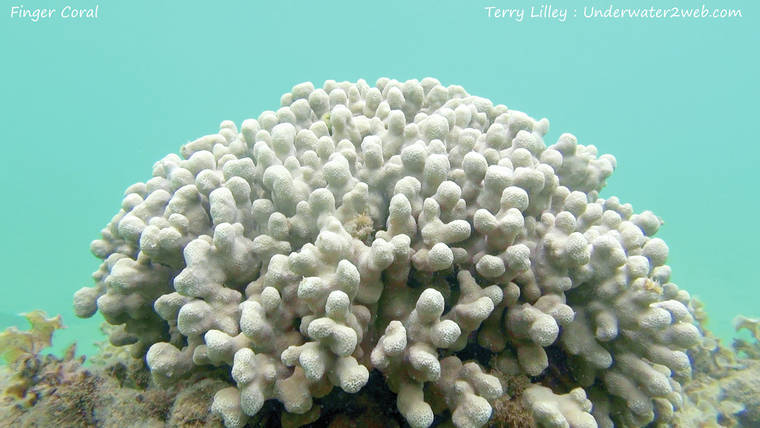The giant finger coral is one of the most common coral species in Hawai‘i, but are often missidentified. This coral can grow for hundreds of years and build an entire reef over time, and when you are walking in downtown Waikiki you are standing on a massive fossil reef of this coral species!
The finger corals look like white fingers growing up from the reef when they are small. But over time they look completely different. Once they become about the size of a basketball they start to take on a more-rounded shape, and when they grow as large as a dining-room table they have a smooth, round surface and the little “fingers” become short and stubby.
The finger corals are always a basic white color, and the larger specimens look similar to the giant mound corals that are normally more brown or purple colors.
Pohaku puna is a shallow-water species of coral, and is super important for the health of marine life, because baby fish and invertebrate species hide in between the coral branches. Certain butterflyfish and tangs feed specifically on the old and dying finger coral polyps, which keeps the coral reef healthy and cleans the corals of dead tissue so new healthy corals can grow.
Hawai‘i has very few coral species versus other Pacific islands like Tahiti that have hundreds of coral species. Entire acres of coral reef in Hawai‘i can just be finger corals, and some of our fish like the yellow tang thrive in these finger coral beds.
Finger corals like all shallow-water corals grow algae within their soft coral tissue, and the coral polyps feed on the sugars the algae produces.
This is why these corals only grow in shallow water, because the algae needs the sunlight to live in the coral tissue.
In the sea, most of the wavelengths of the sunshine are filtered out by the saltwater at 40 to 60 feet depths, so that is why these corals won’t grow in deeper water.
Large finger coral beds are super susceptible to muddy runoff or pollution from land, because that coats the corals, and they can’t absorb the sunshine needed to stay alive.
Keeping our nearshore ocean environment super clean is very important for the entire ocean ecosystem, and that is why we have strict laws here in Hawai‘i about releasing any mud out to sea from building projects or farm lands.
You can see all the Hawaiian coral species at underwater2web.com in my online underwater educational series.
•••
Terry Lilley is a marine biologist living in Hanalei and co-founder of Reef Guardians Hawai‘i, a nonprofit on a mission to provide education and resources to protect the coral reef. To donate to Reef Guardians Hawai‘i go to reefguardianshawaii.org.



Aloha and mAhalo to Terry Lilly. The educational platform and class structures incorporating the keiki to investigate our surrounding ocean with marine biology is far more informative than any KCC or local H.S. campuses, with the exception of the successes of charter school online learning. Terry Lilley has been consistent and brings the teaching-learning experience to higher standards that Kaua’i has otherwise missed out on for five decades that this parent has been observing of.